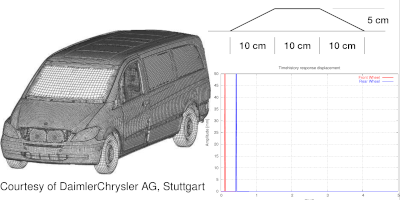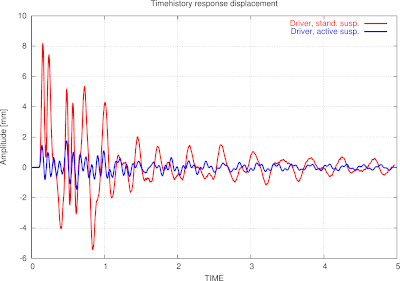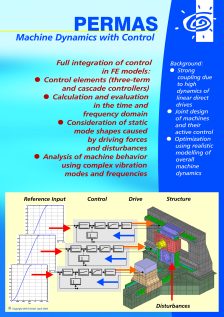Actively Controlled Systems
In the past the design of machine tools structures and their control
have been made separate from each other.
Today's drives have an essentially higher dynamics and this separation
of the design is no longer appropriate due to a strong coupling
between machine and control dynamics.
So, the coupled simulation of structural dynamics and control becomes
a basic requirement for a successful overall design.
For the analysis of controlled structures, the following features are supported:
- Linear controller elements:
-
- Three-term (PID) controller,
- Cascade controller.
Linear controller elements are handled in the same way as any other element, i.e. they are defined by their topology together with some property values. Of course, there may be any number of controller elements in one model. To simplify the input of the controller elements and their different parameters, this is supported by VisPER. - Solution methods:
-
Linear controller elements may be used only in dynamic analyses,
especially within the following solution methods:
- Direct response analysis in frequency and time domain.
- Modal response analysis in frequency and time domain, where the modal basis is enhanced by static mode shapes to represent the internal state variables of the controller elements.
- Complex eigenvalue analysis to judge the effect of controllers on the dynamic behavior.
- Additional static mode shapes:
- Beside the representation of internal state variables in modal space, static mode shapes added to the modal basis may be used to improve the accuracy of results of solution methods in modal space.
- Nonlinear controller element:
- In addition, for nonlinear controls another control element is available, where the dependency of the controller force on any result value in the model may be described by a general function, e.g. by a FORTRAN or C subroutine. Due to nonlinearities, the application of that element is restricted to modal or direct transient response analysis.

Active damping of a vibrating CFRP girder, stresses in first ply,
simultaneous view on both sides of girder.


For more information download the flyer below:
 Click here for more flyers.
Click here for more flyers.
 Click here for more flyers.
Click here for more flyers.
Questions? Ask us!
INTES Ingenieurgesellschaft für technische Software mbH
Management: Rolf Fischer
Breitwiesenstr. 28
70565 Stuttgart
Germany
Commercial register: Stuttgart HRB 10 978
VAT registration number: DE 147803245
Tel.: +49 711 78499-0
✉info@intes.de